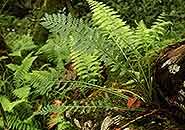Asplenium rutifolium (P.J. Bergius) Kunze
Synonyms |
Caenopteris rutifolium P.J. Bergius |
|---|---|
Common name |
|
Description |
Rhizome erect, up to 50 x 25 mm; rhizome scales dark brown, up to 9 x 1.2 mm, margin subentire, linear-lanceolate to narrowly triangular in outline, 4-9 x 0.8-1.2 (-2.2)mm. Fronds tufted, not proliferous, coriaceous, usually stifly erect. Stipe up to 20 cm, with scattered scales, glabrous at maturity, pale straw-coloured to matt brown when dry. Lamina 7-40 x 2.8-11 cm, 2- to 3-pinnatifid, oblong-lanceolate in outline, basal pinnae hardly or not reduced, apex gradually decrescent. Pinnae in 13-28 pairs, oblong in outline, apex tapering or rounded, up to 3-7 x 0.7-1.7 cm, shortly stalked, hairless or with few small scales below, deeply incised into linear-oblanceolate lobes but with a 2-9 lobed acroscopic basal segment or with some of the lower segments sometimes 2-fid, angled forward at c. 45°, apices rounded. Rhachis narrowly winged or ridged laterally, pale brown when dry with occasional dark brown minute scales. Sori one per lobe, oval, situated on the lateral margin, half way up the lobe, facing toward the pinnae apex, up to 0.8-5 mm; indusium entire, oblong, membranous, to 0.8 mm wide. |
Notes | Confusion possible with A. theciferum; A. rutifolium has sori born on the side margins not on the tips of the ultimate lobes. It resembles A. dregeanum; A. rutifolium is not gemmiferous. |
Derivation | Rutifolium: with leaves like Ruta, a genus of the Rutaceae family. |
Habitat | Deeply shaded moist and dry evergreen forest, riverine forest. |
Distribution worldwide | Africa, Madagascar, Mascarene Isl., Yemen. |
Distribution in Africa |
Burundi, Dem. Republic of Congo, Kenya, Malawi, Mozambique, Rwanda, South Africa, Swaziland, Tanzania , Uganda, Zimbabwe. |
Growth form |
Epiphytic, lithophytic, terrestrial. |
Literature |
|




